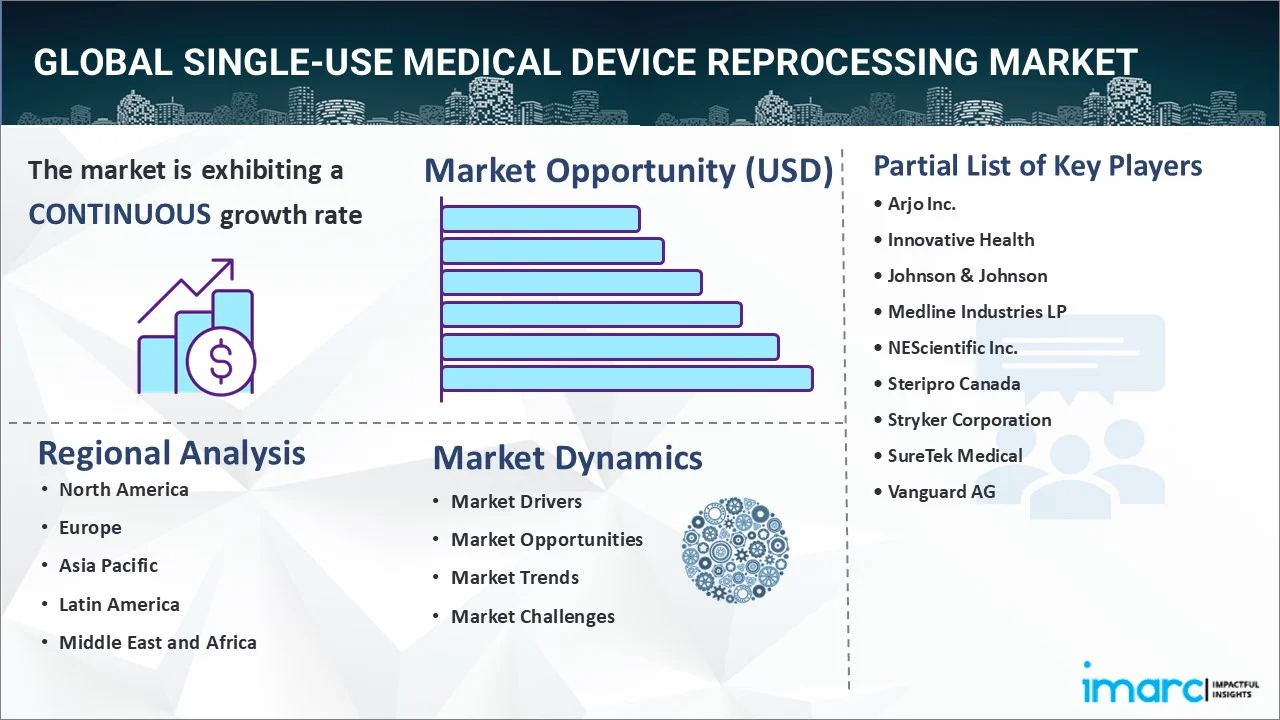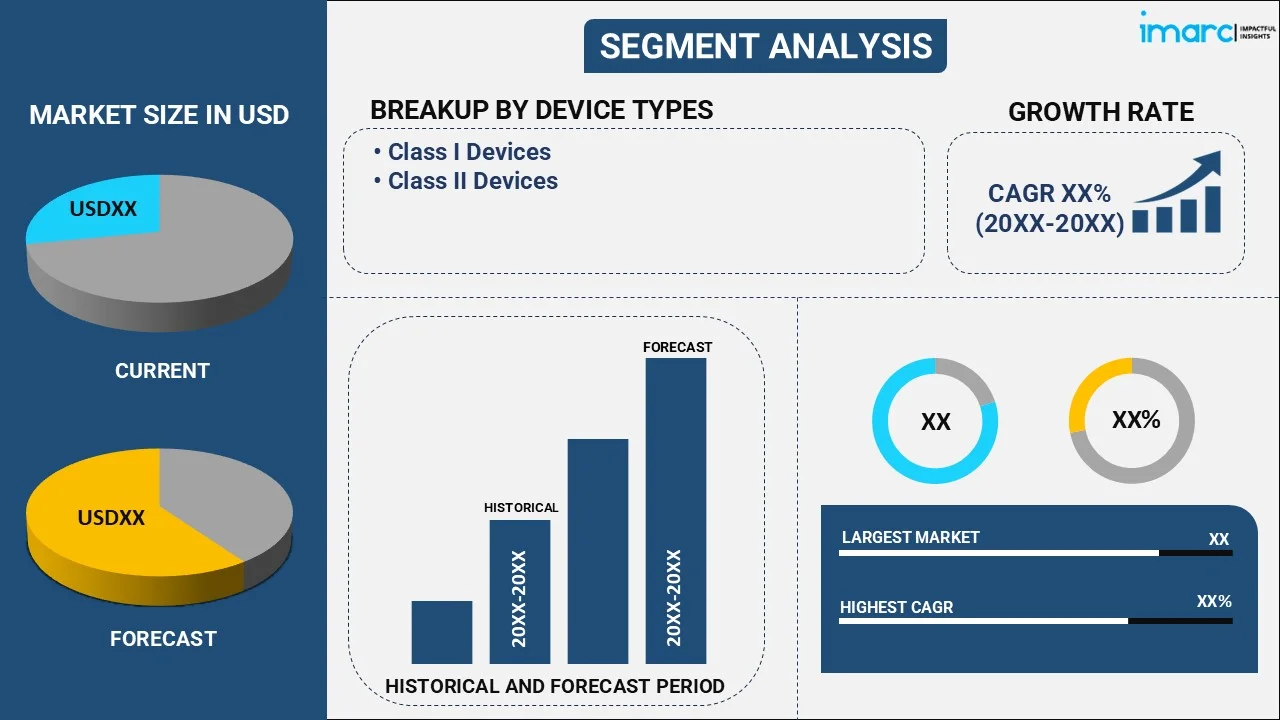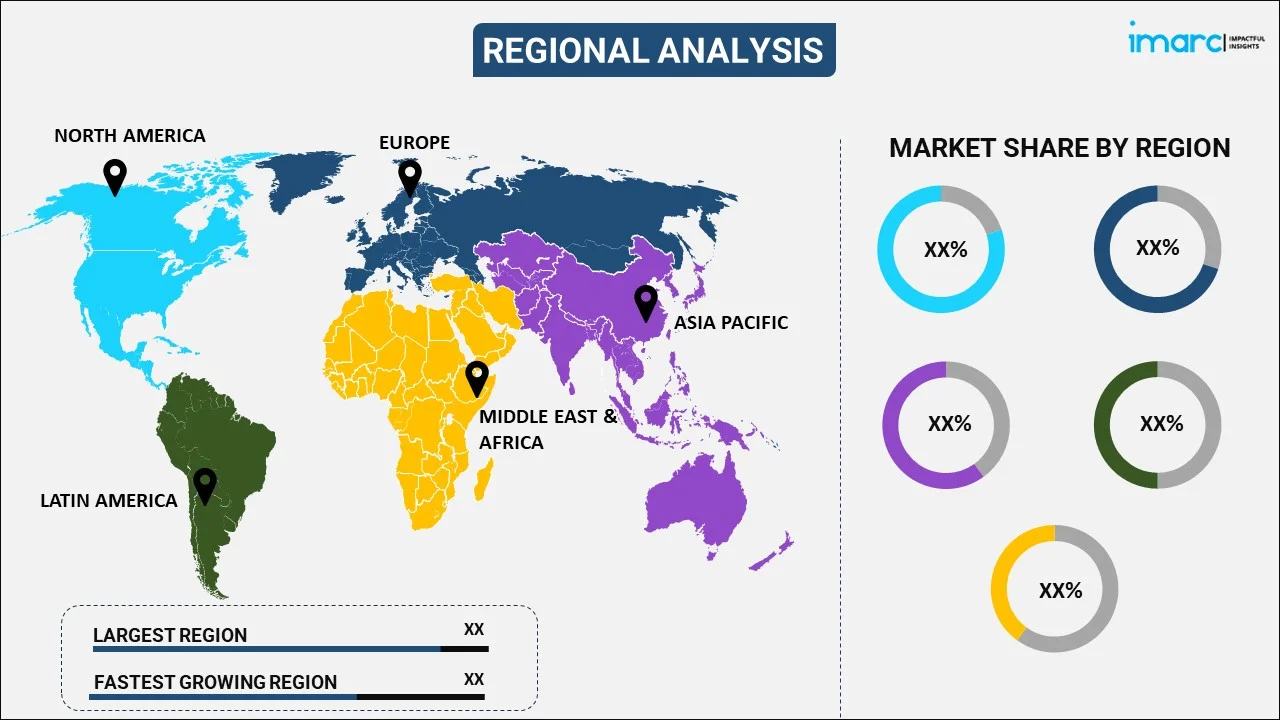
Single-use Medical Device Reprocessing Market Report by Device Type (Class I Devices, Class II Devices), Application (General Surgery, Anesthesia, Arthroscopy and Orthopaedic Surgery, Cardiology, Gastroenterology, Gynaecology, Urology, and Others), End User (Hospitals, Ambulatory Surgical Centers, and Others), and Region 2025-2033
Market Overview:
The global single-use medical device reprocessing market size reached USD 906.6 Million in 2024. Looking forward, IMARC Group expects the market to reach USD 2,533.6 Million by 2033, exhibiting a growth rate (CAGR) of 12.1% during 2025-2033. The rising prevalence of chronic disorders, along with the increasing number of surgical procedures, and quality control methods, and the growing focus on sustainability and reducing medical waste are some of the major factors propelling the market.
|
Report Attribute
|
Key Statistics
|
|---|---|
|
Base Year
|
2024
|
|
Forecast Years
|
2025-2033 |
|
Historical Years
|
2019-2024 |
|
Market Size in 2024
|
USD 906.6 Million |
|
Market Forecast in 2033
|
USD 2,533.6 Million |
| Market Growth Rate 2025-2033 | 12.1% |
Single-use medical device reprocessing is a practice within the healthcare industry aimed at mitigating costs and reducing environmental waste by collecting, cleaning, disinfecting, and refurbishing medical devices that are designed and labeled for single-use. These devices, after appropriate processing, are then reintroduced into the medical setting for subsequent patient use. This approach has gained attention due to its potential to lower expenses associated with medical equipment procurement while also addressing concerns regarding the ecological impact of disposable medical items. The process typically involves rigorous steps to ensure the safety and efficacy of reprocessed devices. Devices are collected and sorted based on their suitability for reprocessing. They then undergo a series of meticulous procedures, including cleaning, disinfection, inspection, testing, and sterilization.

The rising prevalence of chronic disorders, along with the increasing number of surgical procedures, is driving the global market. Moreover, the growing focus on sustainability and reducing medical waste has led to increased interest in reprocessing single-use devices. Reprocessing helps minimize the environmental impact of healthcare by reducing the volume of medical waste that ends up in landfills or incinerators. Furthermore, regulatory agencies in various countries have provided guidelines and approvals for the safe reprocessing of certain single-use medical devices. These regulations support the growth of the reprocessing market by ensuring that reprocessed devices meet stringent safety and quality standards. Ongoing advancements in reprocessing technologies and techniques have improved the effectiveness and safety of the process. These advancements include better cleaning, sterilization, and quality control methods, making reprocessed devices more reliable for clinical use. Also, the establishment of standards and regulations for reprocessing single-use devices has contributed to the growth of the market. Clear guidelines provide healthcare facilities with confidence in the safety and effectiveness of reprocessed devices.
Single-Use Medical Device Reprocessing Market Trends/Drivers:
Cost Containment and Budget Pressures
In an environment of rising healthcare expenditures and financial constraints, hospitals and clinics are seeking innovative ways to maximize resource utilization without compromising patient care. Single-use medical devices are often discarded after a single patient use, leading to significant recurring expenses for replacements. Reprocessing these devices provides an avenue for substantial cost savings, as the refurbished devices can be reintroduced into the clinical setting at a fraction of the cost of new ones. This strategy not only reduces procurement expenses but also contributes to operational efficiency by curtailing the need for frequent supply replenishment. By reallocating funds saved through reprocessing to other critical areas of patient care and infrastructure enhancement, healthcare institutions can alleviate financial pressures while maintaining high standards of medical service delivery.
Environmental Sustainability and Waste Reduction
The healthcare sector generates a significant amount of medical waste, much of which comes from single-use medical devices. These disposables contribute to the accumulation of non-biodegradable materials in landfills, potentially causing environmental harm. Reprocessing offers a solution to this concern by extending the lifespan of these devices through thorough cleaning, disinfection, and sterilization. By reusing reprocessed devices, healthcare facilities can significantly decrease the volume of medical waste generated, promoting a more ecologically responsible approach to medical care. This aligns with the broader societal shift towards environmentally conscious practices and positions healthcare institutions as responsible stewards of both patient health and the environment. As regulatory bodies and patient populations increasingly prioritize sustainability, the adoption of single-use medical device reprocessing becomes a logical choice for healthcare providers looking to reduce their ecological footprint.
Regulatory Support and Technological Advancements
Regulatory agencies, recognizing the potential benefits of reprocessing when conducted with stringent quality controls, have established guidelines and standards to ensure patient safety. As these regulations evolve to ensure the efficacy of reprocessed devices, healthcare facilities are more inclined to incorporate reprocessing into their practices, augmenting the market growth. Moreover, technological advancements have transformed the reprocessing landscape. Innovations in cleaning agents, disinfection methods, and sterilization technologies have enabled more effective removal of contaminants, rendering reprocessed devices comparably safe and reliable as new ones. These advancements also contribute to enhanced quality assurance, reducing the likelihood of adverse events. The marriage of regulatory support and technological progress enhances the credibility of single-use medical device reprocessing, fostering trust among healthcare providers and encouraging broader adoption.
Single-Use Medical Device Reprocessing Industry Segmentation:
IMARC Group provides an analysis of the key trends in each segment of the global single-use medical device reprocessing market report, along with forecasts at the global, regional and country levels from 2025-2033. Our report has categorized the market based on device type, application and end user.
Breakup by Device Type:

- Class I Devices
- Laparoscopic Graspers
- Scalpels
- Tourniquet Cuffs
- Other Class I Devices
- Class II Devices
- Pulse Oximeter Sensors
- Sequential Compression Sleeves
- Catheters and Guidewires
- Other Class II Devices
Class II devices dominate the market
The report has provided a detailed breakup and analysis of the market based on the device type. This includes class I devices (laparoscopic graspers, scalpels, tourniquet cuffs, and other class I devices), and class II devices (pulse oximeter sensors, sequential compression sleeves, catheters and guidewires, and other class II devices). According to the report, class II devices represented the largest segment.
Class II devices encompass a diverse range of medical instruments that pose a moderate to high risk to patients. These devices often require a more complex reprocessing process due to their intricate designs, various components, and critical functionalities. Class II devices are widely utilized across multiple medical specialties, including cardiology, orthopedics, and gastroenterology. This broad usage translates into a higher volume of devices that can be targeted for reprocessing. Furthermore, the cost implications of Class II devices play a pivotal role. Several devices are expensive to procure, and their disposability contributes significantly to healthcare expenditures. As healthcare providers face mounting pressure to optimize budget allocation, the potential for cost savings through reprocessing becomes particularly attractive. The reprocessing of Class II devices offers a practical solution to mitigate financial burdens while still adhering to stringent quality and safety standards.
Breakup by Application:
- General Surgery
- Anesthesia
- Arthroscopy and Orthopaedic Surgery
- Cardiology
- Gastroenterology
- Gynaecology
- Urology
- Others
The report has provided a detailed breakup and analysis of the market based on the application. This includes general surgery, anesthesia, arthroscopy and orthopaedic surgery, cardiology, gastroenterology, gynaecology, urology, and others.
General surgery encompasses a wide array of procedures that address a range of conditions, from routine to complex. This diversity in surgical interventions contributes to the substantial size of the general surgery application segment within the reprocessing market. Single-use devices utilized in general surgery procedures, such as endoscopic tools, laparoscopic instruments, and trocars, are often costly, driving up healthcare expenditures. As hospitals and surgical centers face mounting financial pressures, reprocessing these devices becomes an attractive strategy to control costs without compromising patient safety.
On the other hand, cardiology procedures, ranging from diagnostic angiography to complex interventions, such as angioplasty and stent placement, heavily rely on a variety of single-use medical devices. These devices, often intricate and specialized, contribute to the substantial size of the cardiology application segment. The utilization of reprocessed devices in cardiology not only addresses the financial burden of procuring expensive single-use instruments but also aligns with the industry's shift towards sustainability.
Breakup by End User:
- Hospitals
- Ambulatory Surgical Centers
- Others
Hospitals dominate the market
The report has provided a detailed breakup and analysis of the market based on the end user. This includes hospitals, ambulatory surgical centers, and others. According to the report, hospitals represented the largest segment.
Hospitals are at the forefront of sustainability efforts within the healthcare sector. With increased global awareness of environmental concerns, hospitals are under pressure to reduce their ecological footprint. Reprocessing single-use devices aligns perfectly with this sustainability objective by reducing the volume of medical waste generated. By reprocessing devices instead of disposing of them after a single use, hospitals contribute to waste reduction and minimize their impact on the environment. The adoption of reprocessed devices by hospitals also benefits from advancements in reprocessing technologies and the growing support from regulatory agencies. These factors collectively impel the credibility and safety of reprocessed devices, assuaging concerns about their efficacy. As hospitals focus to provide the best possible care to their patients, the assurance of regulatory compliance and technological sophistication plays a pivotal role in their decision to adopt reprocessed devices.
Breakup by Region:

- North America
- United States
- Canada
- Asia-Pacific
- China
- Japan
- India
- South Korea
- Australia
- Indonesia
- Others
- Europe
- Germany
- France
- United Kingdom
- Italy
- Spain
- Russia
- Others
- Latin America
- Brazil
- Mexico
- Others
- Middle East and Africa
North America exhibits a clear dominance, accounting for the largest single-use medical device reprocessing market share
The market research report has also provided a comprehensive analysis of all the major regional markets, which include North America (the United States and Canada), Asia Pacific (China, Japan, India, South Korea, Australia, Indonesia, and others), Europe (Germany, France, the United Kingdom, Italy, Spain, Russia, and others), Latin America (Brazil, Mexico, and others), and the Middle East and Africa. According to the report, North America accounted for the largest market share.
North America boasts an advanced and well-established healthcare infrastructure. The region is home to a plethora of world-renowned medical institutions, cutting-edge research centers, and innovative healthcare providers. This robust healthcare ecosystem naturally lends itself to the adoption of progressive medical practices, including the reprocessing of single-use devices. As a result, the market experiences a substantial influx of both demand and supply for reprocessed medical devices. Moreover, the stringent regulatory framework in North America serves as a catalyst for the adoption of safe and compliant reprocessing practices. Furthermore, the culture of innovation and technology adoption in North America contributes to the region's leadership in the market. Technological advancements in reprocessing techniques, sterilization methods, and quality control mechanisms are embraced more readily in this environment. Financial considerations also play a significant role in North America's dominance. The high costs associated with healthcare delivery, including the procurement of new medical devices, motivate healthcare institutions to explore cost-effective alternatives.
Competitive Landscape:
Companies are heavily investing in research and development to improve reprocessing techniques. This includes advancements in cleaning, disinfection, and sterilization methods to ensure that reprocessed devices meet or exceed regulatory requirements and maintain their safety and efficacy. Companies are also working closely with regulatory authorities to ensure that their reprocessed devices adhere to the necessary safety and quality standards. They engage in rigorous testing, validation, and documentation to demonstrate that reprocessed devices are equivalent to new ones in terms of performance and safety. Additionally, several companies are expanding their portfolios of reprocessed medical devices. Initially, the focus might have been on common devices, but as the market matures, companies are diversifying into more complex and specialized instruments used in various medical specialties. Moreover, companies are actively involved in educating healthcare professionals about the benefits and safety of reprocessed devices. This involves providing training sessions, workshops, webinars, and educational materials to ensure that healthcare providers have a clear understanding of the reprocessing process and the quality assurances in place.
The report has provided a comprehensive analysis of the competitive landscape in the market. Detailed profiles of all major companies have also been provided. Some of the key players in the market include:
- Arjo Inc.
- Innovative Health
- Johnson & Johnson
- Medline Industries LP
- NEScientific Inc.
- Steripro Canada
- Stryker Corporation
- SureTek Medical
- Vanguard AG
Recent Developments:
- In January 2022, Innovative Health was granted permission to reprocess Boston Scientific's INTELLAMAP ORION High-resolution Mapping Catheter. The catheter is commonly used in atrial fibrillation catheter ablation operations.
- In December 2020, Arjo Inc. announced the acquisition of AirPal, a privately owned US-based company specializing in Air-Assisted Lateral Patient Transfer solutions. The acquisition is part of the Group’s long-term strategic focus towards driving healthier outcomes for people facing mobility challenges.
- In December 2020, Medline Industries LP launched two Healthcare Sustainability Programs. The programs, a Green Product Portfolio, and a Sustainable Packaging Lab, will help hospitals reduce the amount of product waste coming out of their facilities.
Single-Use Medical Device Reprocessing Market Report Scope:
| Report Features | Details |
|---|---|
| Base Year of the Analysis | 2024 |
| Historical Period | 2019-2024 |
| Forecast Period | 2025-2033 |
| Units | Million USD |
| Scope of the Report | Exploration of Historical Trends and Market Outlook, Industry Catalysts and Challenges, Segment-Wise Historical and Predictive Market Assessment:
|
| Device Types Covered |
|
| Applications Covered | General Surgery, Anesthesia, Arthroscopy and Orthopaedic Surgery, Cardiology, Gastroenterology, Gynaecology, Urology, Others |
| End Users Covered | Hospitals, Ambulatory Surgical Centers, Others |
| Regions Covered | Asia Pacific, Europe, North America, Latin America, Middle East and Africa |
| Countries Covered | United States, Canada, Germany, France, United Kingdom, Italy, Spain, Russia, China, Japan, India, South Korea, Australia, Indonesia, Brazil, Mexico |
| Companies Covered | Arjo Inc., Innovative Health, Johnson & Johnson, Medline Industries LP, NEScientific Inc., Steripro Canada, Stryker Corporation, SureTek Medical, Vanguard AG etc. |
| Customization Scope | 10% Free Customization |
| Post-Sale Analyst Support | 10-12 Weeks |
| Delivery Format | PDF and Excel through Email (We can also provide the editable version of the report in PPT/Word format on special request) |
Key Benefits for Stakeholders:
- IMARC’s industry report offers a comprehensive quantitative analysis of various market segments, historical and current market trends, market forecasts, and dynamics of the single-use medical device reprocessing market from 2019-2033.
- The research report provides the latest information on the market drivers, challenges, and opportunities in the global single-use medical device reprocessing market.
- The study maps the leading, as well as the fastest-growing, regional markets. It further enables stakeholders to identify the key country-level markets within each region.
- Porter's five forces analysis assist stakeholders in assessing the impact of new entrants, competitive rivalry, supplier power, buyer power, and the threat of substitution. It helps stakeholders to analyze the level of competition within the single-use medical device reprocessing industry and its attractiveness.
- Competitive landscape allows stakeholders to understand their competitive environment and provides an insight into the current positions of key players in the market.
Key Questions Answered in This Report
The global single-use medical device reprocessing market was valued at USD 906.6 Million in 2024.
We expect the global single-use medical device reprocessing market to exhibit a CAGR of 12.1% during 2025-2033.
The increasing number of surgical procedures, along with the introduction of advanced reprocessing technology, is primarily driving the global single-use medical device reprocessing market.
The sudden outbreak of the COVID-19 pandemic has led to the rising adoption of single-use medical device reprocessing to disinfect visible and non-visible materials for preventing the further transmission of the coronavirus infection.
Based on the device type, the global single-use medical device reprocessing market has been categorized into class I devices and class II devices. Currently, class II devices account for the majority of the total market share.
Based on the end user, the global single-use medical device reprocessing market can be segregated into hospitals, ambulatory surgical centers, and others. Among these, hospitals exhibit clear dominance in the market.
On a regional level, the market has been classified into North America, Asia-Pacific, Europe, Latin America, and Middle East and Africa, where North America currently dominates the global market.
Some of the major players in the global single-use medical device reprocessing market include Arjo Inc., Innovative Health, Johnson & Johnson, Medline Industries LP, NEScientific Inc., Steripro Canada, Stryker Corporation, SureTek Medical, and Vanguard AG.
Need more help?
- Speak to our experienced analysts for insights on the current market scenarios.
- Include additional segments and countries to customize the report as per your requirement.
- Gain an unparalleled competitive advantage in your domain by understanding how to utilize the report and positively impacting your operations and revenue.
- For further assistance, please connect with our analysts.
 Request Customization
Request Customization
 Speak to an Analyst
Speak to an Analyst
 Request Brochure
Request Brochure
 Inquire Before Buying
Inquire Before Buying




.webp)




.webp)












